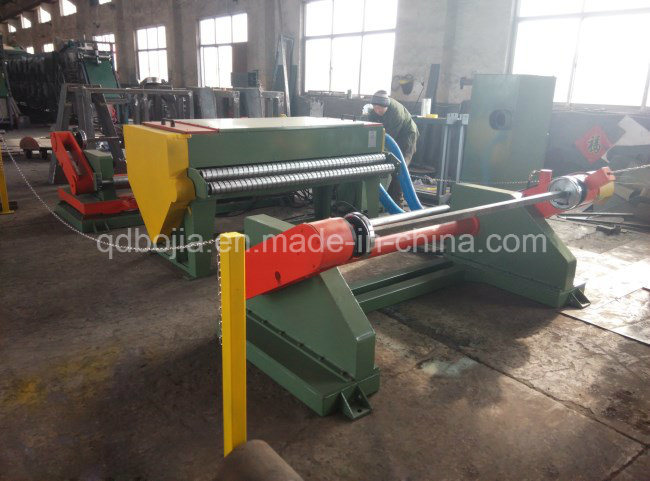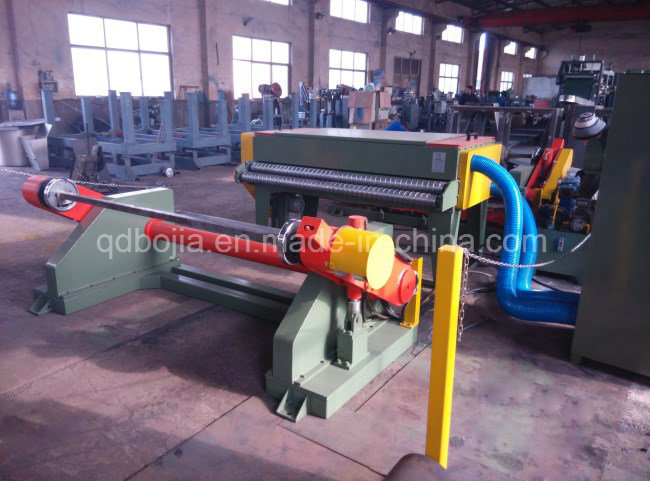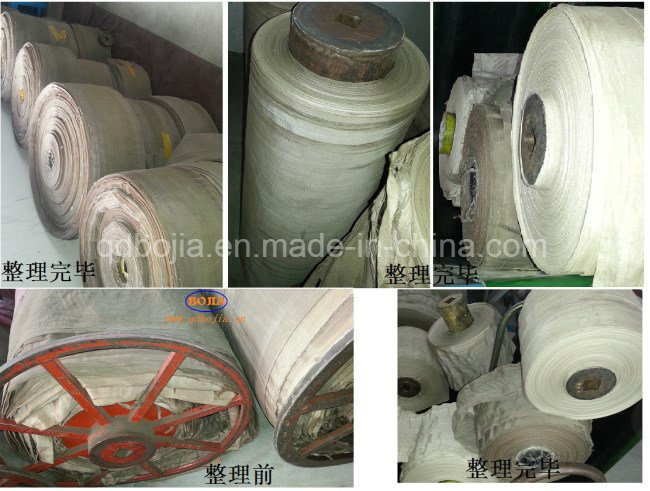Cloth Finishing Machine Auxiliary Equipment
Cushion cloth finishing machine auxiliary equipment
I. Application:
This machine is used for brushing, tidying, and flattening woven fabric to prepare it for the next stage of processing. It ensures the fabric is smooth and ready for further use, improving efficiency in textile production.
II. Technical Specifications:
III. Visual Reference:




IV. Our Services: 1. Our engineers can design custom machines based on your specific needs and send you the drawings for confirmation. We always focus on cost-effectiveness for our clients. 2. Throughout the production process, we will take photos and share them with you so you can track the progress. 3. After delivery, we provide all necessary documents such as packing lists, commercial invoices, and bills of lading. 4. Free English technical documentation including DWG files, installation manuals, user guides, maintenance instructions, and part drawings are available. 5. We offer overseas engineer support and training for your staff to ensure proper operation of the machine. FAQ: 1. What is the delivery time for the machines? This is a custom-made machine tailored to your requirements. The entire process from design to completion typically takes 25–35 days. 2. How do you ensure quality control? Quality is our top priority. Every machine is fully assembled and thoroughly tested before shipment. 3. What is the warranty period? We offer a one-year warranty. We use high-quality components from well-known brands to ensure reliable performance. 4. Can you provide overseas installation and commissioning services? Yes, we can provide on-site support, but the customer is responsible for the associated costs. Small machines usually take 2–3 days, while larger plants may require about 30 days. 5. How can I be sure that the machine delivered meets my order? We guarantee that the machine will meet the specifications discussed and confirmed in the order. Our company values innovation, quality, integrity, and efficiency. We have worked with many global rubber manufacturers, and we welcome you to visit our factory to see real users. 6. How do I get to your factory? Our factory is located in Qingdao City, Shandong Province, China. The nearest airport is Qingdao Liuting Airport. We can arrange a pickup for you upon arrival.
| Model | DBZ-1000 | DBZ-1600 | DBZ-2000 | DBZ-2600 |
| Max Width of Cloth (mm) | 1000 | 1600 | 2000 | 2600 |
| Max Speed of Coiling (r/min) | 40 | 40 | 30 | 25 |
| Brusher Motor (Kw) | 0.75 | 1.1 | 1.1 | 1.5 |
| Coiling Motor (Kw) | 2.2 | 3 | 4 | 5.5 |
| Square Shaft Size (mm) | 30*30 | 35*35 | 40*40 | 45*45 |
| Max Diameter of Cloth (mm) | 1000 | 1000 | 1000 | 1000 |
| Adjustment Range (mm) | 400 | 400 | 400 | 400 |
| Overall Dimensions (LxWxH) (mm) | 4500*1800*1200 | 4500*2300*1200 | 4500*2800*1300 | 4500*3400*1300 |




IV. Our Services: 1. Our engineers can design custom machines based on your specific needs and send you the drawings for confirmation. We always focus on cost-effectiveness for our clients. 2. Throughout the production process, we will take photos and share them with you so you can track the progress. 3. After delivery, we provide all necessary documents such as packing lists, commercial invoices, and bills of lading. 4. Free English technical documentation including DWG files, installation manuals, user guides, maintenance instructions, and part drawings are available. 5. We offer overseas engineer support and training for your staff to ensure proper operation of the machine. FAQ: 1. What is the delivery time for the machines? This is a custom-made machine tailored to your requirements. The entire process from design to completion typically takes 25–35 days. 2. How do you ensure quality control? Quality is our top priority. Every machine is fully assembled and thoroughly tested before shipment. 3. What is the warranty period? We offer a one-year warranty. We use high-quality components from well-known brands to ensure reliable performance. 4. Can you provide overseas installation and commissioning services? Yes, we can provide on-site support, but the customer is responsible for the associated costs. Small machines usually take 2–3 days, while larger plants may require about 30 days. 5. How can I be sure that the machine delivered meets my order? We guarantee that the machine will meet the specifications discussed and confirmed in the order. Our company values innovation, quality, integrity, and efficiency. We have worked with many global rubber manufacturers, and we welcome you to visit our factory to see real users. 6. How do I get to your factory? Our factory is located in Qingdao City, Shandong Province, China. The nearest airport is Qingdao Liuting Airport. We can arrange a pickup for you upon arrival.
Block heat exchangers are compact, modular heat exchange devices classified based on materials, structural designs,
application scenarios, and manufacturing processes. the structured summary of classification as below: Classification by Material
Â
1. Graphite Block Heat Exchanger - Structural Features: Made of impregnated or molded impervious graphite, offering high corrosion resistance and
thermal conductivity. Common types include cylindrical block-type (e.g., Cylindrical Block Graphite Heat Exchanger)
and shell-and-tube graphite heat exchangers. - Applications: Ideal for corrosive media like strong acids or alkalis, such as heat exchange in phosphoric acid production. 2. Ceramic Block Heat Exchanger - Structural Features: Fabricated from monolithic ceramic blocks with elongated cross-sectional channels. The overlapping
arc-shaped channel walls enhance fluid flow efficiency. - Applications: Suitable for high-temperature or high-wear environments in chemical and energy industries. Classification by Structural Design
Â
1. Block-and-Hole Heat Exchanger - Composed of multiple perforated graphite blocks stacked together, allowing fluid exchange through interconnected channels (e.g., *Cylindrical Block Graphite Heat Exchanger*). 2. Shell-and-Tube Block Structure - Modular shell-and-tube designs, including fixed-tube and floating-head types. Examples include *Complex Shell-and-Tube Graphite Heat Exchanger*. 3. Monolithic Block Heat Exchanger - Single-piece structures formed by casting or injection molding, eliminating welds and enhancing pressure resistance (e.g., ceramic or metal monolithic blocks). Classification by Special Functions
Â
1. High-Pressure Thread-Locked Ring Heat Exchanger - Design Features: Employs threaded locking rings for sealing, suitable for high-pressure hydrogen environments (e.g., hydrogenation reaction systems). Corrosion resistance is improved via optimized materials like hydrogen-resistant steel. 2. Corrosion-Resistant Block Heat Exchanger - Examples include *Double-Side Corrosion-Resistant Cylindrical Block Graphite Heater*, designed for strong acid media. Classification by Manufacturing Process
Â
1. Modular Assembly Type - Multiple modules connected via bolts or adhesives, facilitating maintenance (common in graphite heat exchangers). 2. Integrated Monolithic Type - Molded in one piece for high structural integrity, such as cast ceramic or metal blocks. Application Scenarios
Â
- Chemical Industry: Graphite and ceramic block exchangers handle corrosive media (e.g., sulfuric acid, phosphoric acid). - Energy & High-Pressure Systems: Thread-locked ring exchangers are used in petroleum hydrogenation and high-pressure steam systems. - High-Temperature Environments: Ceramic blocks excel in waste heat recovery from high-temperature exhaust gases.
welded plate heat exchanger,compabloc,compabloc exchanger,welded heat exchanger,block heat exchanger,welded plate block heat exchanger,block type heat exchanger
Siping Juyuan Hanyang Plate Heat Exchanger Co., Ltd , https://www.tj-heatexchange.com